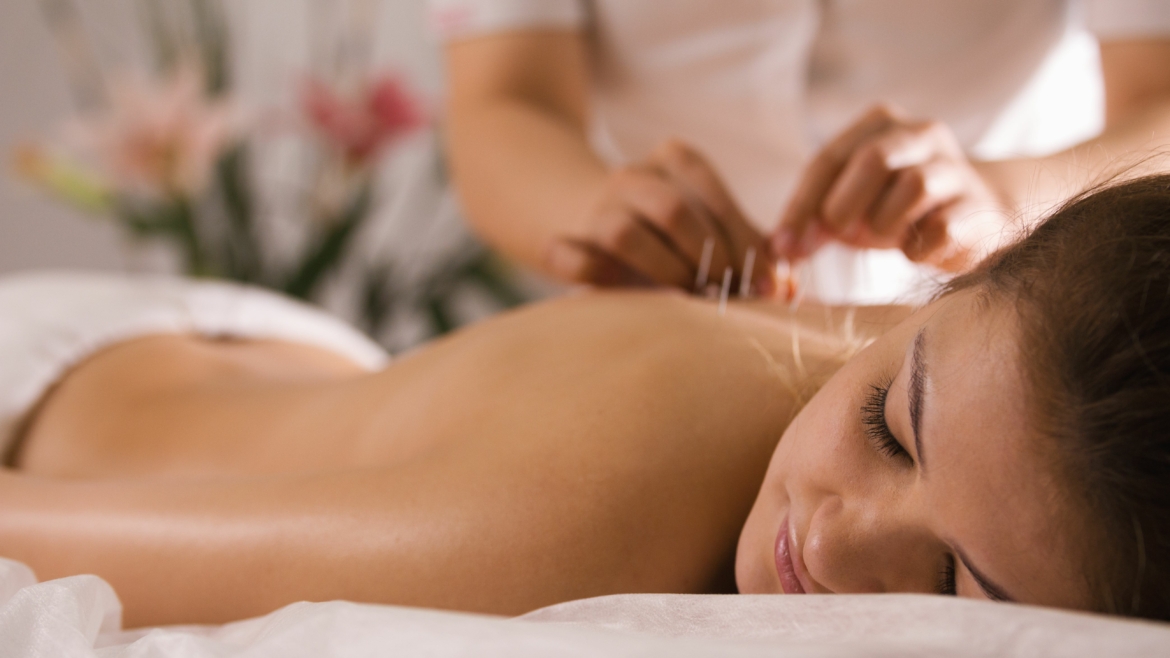Arthritis
According to the Arthritis Foundation, arthritis is very common but not well understood. Actually “arthritis” is not a single disease, it is an informal way of referring to joint pain or joint disease. There are more than 100 different types of arthritis and related conditions. People of all ages, sexes, and races can and do have arthritis, and it is the leading cause of disability in America. More than 50 million adults and 300,000 children have some type of arthritis. It is most common among women and occurs more frequently as people get older.
Arthritis is a complex disorder. As with many disorders, the number one predictor of success with acupuncture is a large number of treatment over a short period of time until the disorder is sufficiently managed, then less frequent maintenance treatments are be required. Further, with all types of arthritis, it is best to start acupuncture treatment early before the disease progresses. Unfortunately, as arthritis progresses, the usefulness of acupuncture will be reduced.
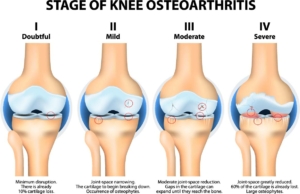
Arthritis- Osteoarthritis (Degenerative Arthritis)- This is the most common type of arthritis. When the cartilage (the slick, cushioning surface on the ends of the bones) wears away, bone rubs against bone, causing pain, swelling, and stiffness. Over time, joints can lose strength and pain may become chronic. Risk factors include excess weight, family history, age, and previous injury (osteoarthritis typically starts at the site of a previous injury).
How does acupuncture help osteoarthritis?
Chronically tight muscles apply physical pressure on joints which increases their rate of degeneration. Further, these tight muscles result in a reduced blood supply to the joints. Blood carries oxygen and nutrients to the joints, and low oxygen and poor nutrition reduce the natural ability of the joint to heal. One way acupuncture improves arthritis is by relaxing these chronically tight muscles.
When osteoarthritis affects a joint such as the knee, it results in subtle changes to the way a person walks and moves. This can cause further problems, such as low back pain and/or hip pain, and also increase the rate of degeneration, because of increased wear and tear on a joint that is moving in a way that it wasn’t designed to move. Acupuncture has been shown to improve gait in patients with osteoarthritis (“Immediate Effects of Acupuncture Treatment on Intra- and Inter-Limb Contributions to Body Support During Gait in Patients with Bilateral Medial Knee Osteoarthritis” http://www.worldscientific.com/doi/abs/10.1142/S0192415X17500033
In multiple studies, acupuncture has also been found to be an effective treatment for pain and physical dysfunction associated with osteoarthritis of the knee (“Acupuncture and Osteoarthritis of the Knee: A Review of Randomized, Controlled Trials”) https://www.ncbi.nlm.nih.gov/pmc/articles/PMC2810544/
Another way acupuncture helps with arthritis is the fact that acupuncture stimulates cartilage production. The way it does this is by stimulating the release of adenosine in the body. Adenosine is a endogenous chemical (meaning our body makes it naturally), and animal studies show that acupuncture stimulates the release of adenosine, and after 30 minutes of acupuncture, concentrations of adenosine rise 24 times greater than baseline levels. Adenosine plays a role in many biochemical processes, including energy production and transfer in cells (in the form of ATP), and signal transduction (in the form of cAMP). It also plays a role in the regulation of blood flow to internal organs. In other words, it is a power neuromodulator that helps our body recover and heal. Adenosine has been specifically shown to help cartilage repair and inhibit the progression of osteoarthritis. (“Endogenous Adenosine Maintains Cartilage Homeostasis and Endogenous Adenosine Inhibits Osteoarthritis Progression”) http://www.nature.com/articles/ncomms15019
Arthritis- Inflammatory (Rheumatoid Arthritis and Psoriatic Arthritis)
A healthy immune system is protective. It generates internal inflammation to get rid of infection and prevent disease. But the immune system can go awry, mistakenly attacking the joints with uncontrolled inflammation, potentially causing joint erosion and may damage internal organs, eyes, and other parts of the body. Researchers believe that a combination of genetics and environmental factors can trigger autoimmunity.
Acupuncture has an immunomodulatory effect. Researchers at Rutgers University New jersey Medical School reported that electro-acupuncture on an acupoint traditionally used to strengthen the constitution activated two nerve tracts in mice that led to the production of a biochemical that reduced sepsis (infection) in the mice. This led to the discovery of previously unknown neuroimmune pathways and is considered a breakthrough in neuroimmunology.
In another study, impaired immune function in anxious women were significantly improved by acupuncture. Acupuncture brought their blood values closer to those of healthy people, exerting a modulatory effect on the immune system.
The same study showed that the most favorable effects of acupuncture on the immune function appear 72 hours after the acupuncture session and persists for one month after the end of the complete course of treatment. (“Effect of Acupuncture Treatment on the Immune Function Impairment Found in Anxious Women”) https://www.ncbi.nlm.nih.gov/pubmed/17265549
Further, research has shown that acupuncture combined with a special herbal formula produces positive outcomes in RA patients. http://en.cnki.com.cn/Article_en/CJFDTotal-ZYLY201303013.htm
Arthritis- Infectious
A bacteria, virus, or fungi can enter the joint and trigger inflammation. Examples of organisms that can infect joints are salmonella and shigella (food poisoning or contamination), chlamydia and gonorrhea (sexually transmitted diseases), and hepatitis C (a blood-to-blood infection). In many cases, timely treatment with antibiotics may clear the joint infection, but sometimes the arthritis becomes chronic.
Arthritis- Metabolic (Gout)
Uric acid is formed as the body breaks down purines, a substance found in human cells and many foods. Some people have high levels of uric acid because they naturally produce more than is needed or the body can’t get rid of the uric acid quickly enough. In some people, the uric acid builds up and forms needle-like crystals in the joint, resulting in sudden spikes of extreme joint pain (a gout attack). Gout can come and go in episodes or, if the uric acid crystals aren’t reduced, it can become chronic, causing ongoing pain and disability.
Gout’s symptoms can be alleviated with acupuncture, but the best way to get rid of gout once and for all is through metabolic treatment and diet. Increased levels of uric acid are correlated with high blood sugar levels, so diet and lifestyle play large roles in gout. Also, fructose (including high fructose corn syrup), alcohol (especially beer), and purines (found in high concentrations in organ meats, beef, bacon, pork, and lamb) should be avoided.
Research shows that tart cherry juice/cherries are correlated with a reduced risk of gout attacks. https://www.ncbi.nlm.nih.gov/pmc/articles/PMC3510330/
Carpal Tunnel Syndrome
Carpal Tunnel Syndrome (CTS) is a medical condition caused by compression of the median nerve as it travels through the wrist at the carpal tunnel. This leads to a range of structural and functional changes, which ultimately leads to tissue damage and chronic pain.
Risk factors include obesity, repetitive wrist work, pregnancy, rheumatoid arthritis, and possibly hypothyroidism and diabetes. It typically begins in adulthood and most patients are 40-60 years old. It is more common in women than men.
Permanent nerve, tendon, and muscle damage can occur if CTS is not treated. Early and proper acupuncture treatment of CTS not only relieves pain and numbness, it usually can prevent permanent damage to the wrist and hand. Since other conditions (carpal bone dislocations, rheumatoid thickening of the sheath, cervical radiculopathy) can mimic CTS, a physical exam is usually performed and in some cases a nerve velocity conduction study (NVCS) will be completed.
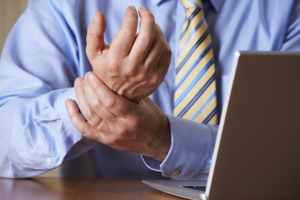
Local acupuncture into the carpal tunnel itself helps to repair local tissue damage and reduces local inflammation, while distal acupuncture (needles inserted at specific acupuncture points away from the local site of injury) helps to improve “neuroplasticity” of the brain and helps the brain to undo the damage that strong pain signals, over a long period of time, can cause.
In other words, local acupuncture helps correct damage to the carpal tunnel itself (original cause of problem), while distal acupuncture helps correct the effects of long-term pain on the brain by “rewiring” the brain. There have been many studies on acupuncture can reverse this process, especially in carpal tunnel syndrome.
“Neuroplasticity in Carpal Tunnel Syndrome” https://www.researchgate.net/publication/287282522_Neuroplasticity_in_carpal_tunnel_syndrome
“Acupuncture-Evoked Response in Somatosensory and Prefrontal Cortices Predicts Immediate Pain Reduction in Carpal Tunnel Syndrome” https://dash.harvard.edu/bitstream/handle/1/11717680/3703406.pdf?sequence=1
“Rewiring the Primary Somatosensory Cortex in Carpal Tunnel Syndrome with Acupuncture” https://academic.oup.com/brain/article-abstract/doi/10.1093/brain/awx015/3058778/Rewiring-the-primary-somatosensory-cortex-in
Headache- General
Headaches are among the most common medical complaints, but the exact nature of headache pain remains unclear. Interestingly, the brain itself is not sensitive to pain because it lacks pain receptors. However, there are many pain-sensitive structures in the skull and neck, and these respond well to acupuncture treatment.
There are many triggers of headaches including: fatigue, sleep deprivation, side effects of medications or recreational drugs, dehydration, blood sugar disorders, viral infections, common cold, head injury, dental issues, sinus issues, stress, food allergies, hypertension, chemical exposure, and musculoskeletal disorders.
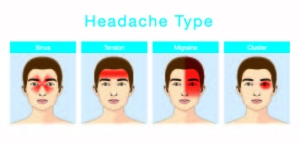
According to The Acupuncture Evidence Project (www.acupuncture.org.au), there is strong evidence supporting the effectiveness of acupuncture for headache (chronic, tension-type, and migraine). Some headaches can be eliminated with acupuncture, while others can be successfully managed by reducing the frequency, intensity, and/or duration of headache pain. How well a patient responds to acupuncture depends on the clinical presentation. In the Traditional Chinese Medicine (TCM) model, all headaches are viewed as systemic problems and are treated with a holistic approach.
Headache- Tension Type
Tension-Type headaches (TTH) are the most common form of headache, occurring in about 75% of the general population. TTH commonly last from 30 minutes to seven days, and the pain is commonly described as dull pain across the forehead, temples, or around the back of the head.
Cochrane Reviews are systematic reviews of primary research in human healthcare and are internationally recognized as the highest standard in evidence-based healthcare. A Cochrane Review on acupuncture for tension-type headaches was completed in 2016. After analyzing the data, the researchers concluded “Acupuncture consisting of at least six treatment sessions can be a valuable option for people with frequent tension type headaches”. They also determined that how often patients got a tension type headache was cut in half and the effect of acupuncture was still present after six months. (“Cochrane Review: Acupuncture for Tension Type Headaches”) http://www.cochrane.org/CD007587/SYMPT_acupuncture-tension-type-headache
Further, a study conducted in the United Kingdom concluded that “the improvement in quality-adjusted-life-years was achieved at a very low cost compared with routine medical care. Patient who received acupuncture had 22 fewer days of headaches, 15% lower use of medications, and 25% fewer visits to medical providers over one year compared to those who had usual medical care. (“Cost Effectiveness Analysis of a Randomized Trial of Acupuncture from Chronic Headache in Primary Care”) https://www.ncbi.nlm.nih.gov/pubmed/15023830
Headache- Migraine
Migraine headache is a result of specific changes within the brain. It causes severe head pain that is often accompanied by sensitivity to light, sound, or smells. According to the National Headache Foundation, more than 37 million Americans suffer from migraine, and if affects three times as many women as men.
Cochrane Reviews are systematic reviews of primary research in human healthcare and are internationally recognized as the highest standard in evidence-based healthcare. A Cochrane Review for the use of acupuncture for treating migraine was conducted in 2009. The researchers concluded “Available studies suggest that acupuncture is at least as effective as, or possibly more effective than, prescription drug treatment, and has fewer adverse effects. Acupuncture should be considered a treatment option for patients willing to undergo this treatment”. (“Acupuncture for Migraine Prophylaxis”) https://www.ncbi.nlm.nih.gov/pubmed/19160193
Another Cochrane Review on acupuncture for preventing migraine was conducted with similar results (acupuncture was very effective and outperformed drugs). Researchers concluded “The available evidence suggests that a course of acupuncture consisting of at least six treatments can be a valuable option for people with migraine”. They also state the frequency of migraine for those receiving acupuncture was basically cut in half and people receiving acupuncture reported less side effects that people receiving drugs. http://cochrane.org/CD001218/SYMPT_acupuncture-preventing-migraine-attacks
Hip Pain- Hip Bursitis/Degeneration/Osteoarthritis
Hip joints sustain enormous stress in daily activities such as walking. For example, during walking, when the left limb is lifted, the right hip joint is subjected to compression forces several times greater than the body weight. A person does not feel this huge force of compression because there are no nerves in the articular cartilage. When this cartilage is eroded by degenerative disease or aging, the bony head of the femur, which is richly supplied by sensory nerves, produces pain during every step because of compression force.
Hip bursitis (also called trochanteric bursitis) typically presents as pain over the affected bursa. The bursa is a small fluid filled sac that reduces friction between the moving parts of the hip.
When this bursa becomes inflamed, the pain may be so severe that the patient cannot lie on the affected side or even sit comfortably. Usually the patient feels pain during activity, but the pain can also vary. It can be local, right over the greater trochanter, in the iliac crest, or even in the knee region.
Hip bursitis can be treated very effectively by acupuncture because needling relaxes muscles, activates local anti-inflammatory reactions, and encourages tissue regeneration. However, it is important to note that unlike the upper limbs, the hips bear weight which makes them not only more susceptible to degenerative change but also makes healing of injuries more difficult and prolongs the process of restoring normal physical function.
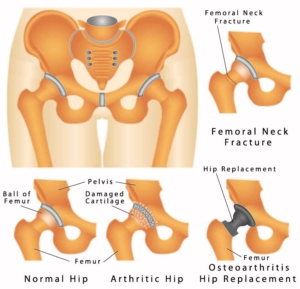
Hip: Post Replacement Surgery Recovery
When all other therapies have failed surgery may be necessary to relieve pain and restore function to the hip. The number of total hip replacement surgeries performed in the U.S. has increased substantially over the last 10 years and has become much more common in younger people.
However, it may be months following surgery before the patient is fully healed, and the patient may suffer significantly throughout the recovery period.
Nerves heal at a slow rate, approximately one millimeter per day (about one inch per month). Recent studies demonstrate that “acupuncture significantly improves motor nerve conduction velocity and amplitude and also promotes functional nerve repair”. https://www.ncbi.nlm.nih.gov/pmc/articles/PMC4357096/
Further, acupuncture accelerated recovery after general anesthesia (“Acupuncture Accelerates Recovery after General Anesthesia: A Prospective Randomized Controlled Trail”) https://www.ncbi.nlm.nih.gov/pubmed/25797640
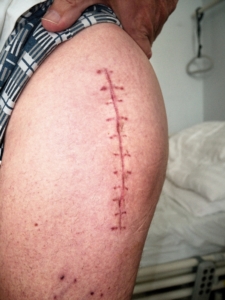
Knee Pain- General Pain, Sprain, Strain
Everyday activities such as walking, climbing stairs, or rising from a chair, as well as athletic activities such as running and jumping, depend on the functional integrity of the knee. Any diseases or trauma to the bone or soft tissues can significantly impair the knee’s ability to perform basic functions.
Knee pain is usually caused by degenerative changes, inflammation, traumatic injury, infections, or referred pain from hip or spine disorders. Knee pain is commonly seen clinically, and acupuncture is very effective in restoring functional integrity of the knee.
In multiple studies, acupuncture has also been found to be an effective treatment for pain and physical dysfunction associated with osteoarthritis of the knee.
(“Acupuncture and Osteoarthritis of the Knee: A Review of Randomized, Controlled Trials”) https://www.ncbi.nlm.nih.gov/pmc/articles/PMC2810544/
(“The effect of Acupuncture on the Symptoms of Knee Osteoarthritis – An Open Randomized Control Study”) https://wwwncbi.nlm.nih.gov/pubmed/15077933
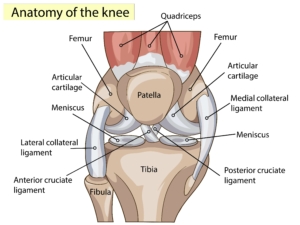
Knee Pain- Medial or Lateral Meniscus Injury, ACL/PCL Injury/Patellar Bursitis/Osteoarthritis
Everyday activities such as walking, climbing stairs, or rising from a chair, as well as athletic activities such as running and jumping, depend on the functional integrity of the knee. Trauma to the bone or soft tissues can significantly impair the knee’s ability to perform basic functions. In the early phases, a patient may feel weakness rather than pain.
Acupuncture is commonly used to reduce pain and promote healing. When there is damage to the soft tissues of the knee, electro-acupuncture is typically used. Electro-acupuncture can reduce pain and inflammation, and significantly improve the healing of soft tissues. An amazing study published in the journal Stem Cell in 2017 showed that electro-acupuncture in rats, horses, and humans stimulated and mobilized mesenchymal stem cells into systemic circulation. This resulted in higher thresholds for injury-induced pain and considerably increased a type of collagen that promotes tendon repair and anti-inflammatory cells known to be predictors of faster healing time. https://www.sciencedaily.com/releases/2017/03/170316174225.htm
http://onlinelibrary.wiley.com/doi/10.1002/stem.2613/full
Researchers compared the effectiveness of acupuncture to physical therapy in a 2016 study. After analyzing their results, they concluded “These results indicate that acupuncture represents a certain clinical effect on knee osteoarthritis which is superior compared to physiotherapy (physical therapy), and hint at the possible roles of acupuncture in promoting cartilage repair” (“Influence of Acupuncture in Treating Knee Osteoarthritis and Cartilage Repairing”) https://www/ncbi.nlm.nih.gov/pmc/articles/PCM5040698/
Knee Pain- Post Knee Replacement Surgery Recovery
When all other therapies have failed surgery may be necessary to relive pain and restore function to the knee. The number of total knee replacement surgeries performed in the U.S. increased 93% between 2001 and 2011, and it is expected to increase to 3.48 million surgeries annually by 2030.
However, it may be months following surgery before patients are fully healed, and the patient may suffer significantly throughout the recovery period.
Nerves heal at a slow rate, approximately one millimeter per day (about one inch per month). Recent studies demonstrate that “acupuncture significantly improves motor nerve conduction velocity and amplitude and also promotes functional nerve repair”. https://www.ncbi.nlm.nih.gov/pmc/articles/PCM4357096/
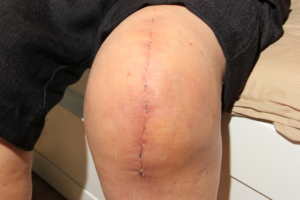
Further, acupuncture accelerates recovery after general anesthesia (“Acupuncture Accelerates Recovery after General Anesthesia: A Prospective Randomized Controlled Trail”) https://www.ncbi.nlm.nih.gov/pubmed/25797640
After a knee replacement surgery, always follow all instructions and restrictions provided by your surgeon. The length of time your restrictions are in place is determined by your surgeon and how quickly you heal. Acupuncture can significantly shorten the recovery process and result in improved outcomes including the reduction of possible complications. Acupuncture should be a part of every knee replacement surgery patient’s recovery process. For best results, it’s better to start acupuncture as soon after the surgical procedure as realistically possible.
Low Back Pain- General Pain/Strain
Low back pain is one of the most common problems seen in the United States. Statistics show that about 150 million Americans suffer from acute or chronic low back pain. Common causes of low back pain include improper lifting, poor posture, lack of regular exercise, overuse, and being overweight. Other causes include arthritis, fracture, degeneration, and herniated intervertebral discs.
Medications are commonly used to manage low back pain, but both over the counter and prescription medications have been shown to only provide limited relief and have unwanted side effects, some of them severe. Luckily, most musculoskeletal disorders respond very well to acupuncture therapy.
Research had confirmed what the Chinese knew 2,000 years ago – acupuncture is very useful for conditions like chronic low back pain (“Acupuncture for Low back Pain: An Overview of Systematic Reviews”) https://www.ncbi.nlm.nih.gov/pcm/articles/PCM4364128
In 2017 the American College of Physicians (ACP) issued a “strong recommendation” of using acupuncture as a first line therapy for the treatment of low back pain that does not radiate down the leg (“Noninvasive Treatments for Acute, Subacute, and Chronic Low Back Pain: A Clinical Practice Guideline from the American College of Physicians”) https://annals.org/aim/article/2603228/noninvasive-treatments-acute-subacute-chronic-low-back-apin-clinical-practice
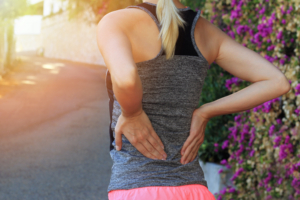
Low Back Pain- Herniated Disc, Bulging Disc, Slipped Disc, Herniated Nucleus Pulposus (HNP) – Spinal discs are soft, compressible discs that separate interlocking bones (vertebrae) that make up the spine. These discs act as shock absorbers for the spine, allowing it to flex, bend, and twist. Bulging, herniated or ruptured discs can occur when the intervertebral discs become compressed and bulge outward (herniate) or rupture, causing nerve irritation.
Sciatica – Sciatica is caused by compression of the sciatic nerve, the large nerve that travels through the buttocks and extends down the back of the leg. This compression causes shock-like or burning low back pain combined with pain through the buttocks and down one leg, occasionally reaching the foot. In extreme cases, the symptoms may involve not only pain but numbness and muscle weakness in the leg because of interrupted nerve signaling.
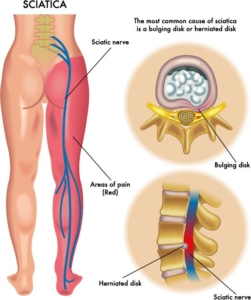
Degenerative Disc Disease (DDD) – Degenerative disc disease is a term used to describe the age-related changes in the discs.
Degenerative Joint Disease (DJD) – Degenerative joint disease is also known as osteoarthritis and is cause by the inflammation, breakdown, and eventual loss of cartilage of the joints.
Stenosis – Stenosis is a narrowing of the spinal column that puts pressure on the spinal cord and nerves that can cause pain or numbness with walking and over time leads to leg weakness and sensory loss.
A wide range of medications are used to treat low back pain, both over the counter and prescription. The risks of these drugs include interactions with other medications and the possibility of side effects, including liver damage, gastrointestinal bleeding, heart damage, kidney damage, and addiction. In fact, because of the misuse of powerful pain medications, the U.S. is currently experiencing a public health crisis known as the “Opioid Epidemic”.
According to the National Institute of Health’s National Institute of Drug Abuse, in the late 1990’s pharmaceutical companies reassured the medical community that patients would not become addicted to prescription opioid pain relievers, and healthcare providers began to prescribe them at greater rates. This subsequently led to widespread misuse of these medications before it became clear that these medications could indeed by highly addictive. Now, every day, more than 90 American die after overdosing on opioids and the economic burden of prescription opioid misuse in the U.S. in $78.5 billion a year (www.drugabuse.gov).
Acupuncture can play a large role in helping to address this crisis, and several large acupuncture organizations have written white papers on the evidence, cost-effectiveness, and care availability for acupuncture as a primary, non-pharmacologic method for pain management. In fact, acupuncture has even been shown to be more effective than opioids for sciatica. https://www.ncbi.nlm.nih.gov/pubmed/24412033
Lumbar disc herniation, like all spinal herniations, can fully heal and resolve. In fact, there are many published case reports of this occurring.
https://www.ncbi.nlm.nih.gov/pubmed/29607997
https://www.ncbi.nlm.nih.gov/pubmed/25883664
Acupuncture can promote healing of a herniated disc. In one published case report, a patient had a large lumbar disc herniation (confirmed by MRI) with radiating pain for two years. Two courses of physical therapy provided no relief and she could not take NSAIDS due to drug -induced gastric bleeding. She was referred to a surgeon, but did not want lumbar surgery. Instead she chose to try acupuncture.
Acupuncture was given twice per week for seven weeks, and the results were excellent. The patient was pain free and continued to be pain free at a three month follow up. Further, a follow up MRI showed considerable improvement. (“Lumbar Disc Herniation Treated with Auricular Acupuncture: Why Do They Wait?”) http://aim.bmj.com/content/32/5/430
Acupuncture can help many patient with herniated discs and/or sciatica to experience a reduction of their pain and muscle spasms and resume normal work and lifestyle for years.
Neck Pain- Cervical Sprain/Strain/Whiplash
The neck serves two basic functions: 1) as a passage way for blood, nerves, food, and air, and 2) as a pedestal to support the head. About two dozen muscles in the neck and upper back support and move the head and neck, and many important structures are crowded into this area as well. Neck pain can come from bad posture during work related activities, improper sleeping position, or it can be caused by cumulative trauma from frequent repetitions of the same activity, sports injuries, or car accidents.
Sprain, strain, fatigue, inflammation, low circulation, or other injuries can cause weakness and tightness in one or more major muscle groups, causing the discs and joints to support more weight than they should, which in turn leads to chronic pain and premature degeneration.

Acupuncture has been shown to help many patients with neck pain to experience a reduction of pain (frequency, duration, and intensity), reduce flare ups, slow degeneration, and resume normal work and lifestyle for years.
Cochrane Reviews are systematic reviews of primary research in human healthcare and are internationally recognized as the highest standard in evidence-based healthcare. A Cochrane Review in 2006 summarized the most current scientific evidence on the effectiveness of acupuncture for acute, subacute, and chronic neck pain. After analyzing the data, the researchers concluded “There is moderate evidence that those that received acupuncture reported less pain at short term follow up” https://www.ncbi.nlm.nih.gov/pubmed/16856065
Neck Pain- Cervical Herniated Pulposus (HNP)/Herniated Disc/Bulging Disc
Spinal discs are soft, compressible discs that separate interlocking bones (vertebrae) that make up the spine. These discs act as shock absorbers for the spine, allowing it to flex, bend, and twist. Bulging, herniated, or ruptured discs can occur when the intervertebral discs become compressed and bulge outward (herniate) or rupture, causing nerve irritation.
The tough covering of a disc in the spine can tear (rupture), causing pain. The soft, jelly-like interior may bulge out (herniate) through the covering, causing more pain. Pain occurs because the bulge puts pressure on the spinal nerve root next to it. Sometimes the nerve is damaged. A disc may herniate because of a sudden injury or repeated minor injuries.
Where the pain occurs depends on which disc is herniated and which spinal nerve is affected. The pain is felt along the pathway of the nerve compressed by the herniated disc. The pain varies from slight to debilitating, and movement intensifies the pain. Numbness and muscle weakness may also occur.
It is possible for cervical disc herniation (and all spinal disc herniation) to completely heal and fully resolve. In fact, there are published case reports of acupuncture promoting this self-healing. (“Acupuncture and Spontaneous Regression of Radiculopathic Cervical Herniated Disc”) https://www.ncbi.nlm.nih.gov/articles/PMC4331934/
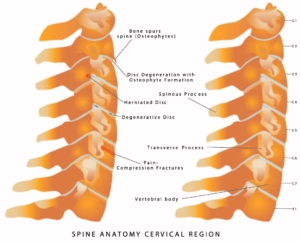
Neck Pain- Spondylolisthesis
Spondylolisthesis is the forward displacement of a vertebrae over a lower vertebrae. The forward slippage of the vertebrae can lead to spinal stenosis and radiculopathy (radiating pain, numbness, and/or weakness along the path of the nerve), which results in muscles that are tight and painful in response to movement. Spondylolisthesis is classified according to severity, from Grade 1 (mild) to Grade 4 (severe).
Acupuncture has been shown to help many patients with Grade 1 and 2 spondylolisthesis and associated disc problems to experience a reduction of their pain and muscle spasms and resume normal work and lifestyle for years. Unfortunately with Grade 3 or 4 spondylolisthesis acupuncture can only provide limited relief.
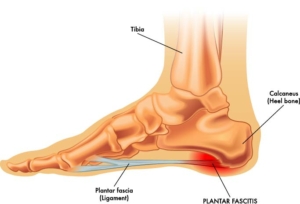
Plantar Fasciitis
Plantar Fasciitis (PF) is inflammation of the thick band of tissue that connects the heel bone to the toes. PF typically causes stabbing pain that is worse with the first steps in the morning. The exact cause of PF is unknown, but things which increase the risk of getting it are: age, obesity, performing certain types of exercises (running, jumping, dancing), poor foot mechanics, and occupations which keep you standing on your feet for long periods of time.
Acupuncture can be used to treat PF. In a 2012 study, patients received electro-acupuncture twice per week for five weeks, along with conventional care (stretching exercises, shoe modification, and rescue pain killers). This group was compared to a control group, who only received conventional care.
Electro-acupuncture combined with conventional treatments provided a success rate of 80% in chronic plantar fasciitis, and the combination was more effective than conventional treatments alone. These effects lasted for at least six weeks after treatment. (“Efficacy of Electro-Acupuncture in Chronic Plantar Fasciitis: A Randomized Controlled Trial”) https://www.ncbi.nlm.nih.gov/pubmed/23227789/
In one interesting study, a single acupuncture point in the wrist or hand was used to treat PF. After treatment five times per week for two weeks acupuncture provided significant pain relief (40% reduction in pain at the one month follow up), and the results not only lasted for six months after treatment, they continued to improve over the six months after treatment (“Acupuncture Treatment for Plantar Fasciitis: A Randomized Controlled Trail with Six Months Follow up”). https://www.ncbi.nlm.nih.gov/pmc/articles/PMC3094706/
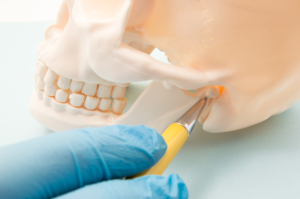
TMJ/TMD Recovery
The temporomandibular joints (TMJ) are the hinge like joints that connect the mandible (lower jaw) to the temporal bone of the skull. The TMJ is susceptible to various disorders such as inflammation, osteoarthritis, or rheumatoid arthritis. Pain also may result from mechanical damage such as wear and tear on the joints, injury, tightened jaw muscles, stress, an improperly aligned bite, and poorly fitting braces or other dental appliances. Further, chronic tension and anxiety may cause a person to habitually clench the jaw or grind the teeth while sleeping. Once a person develops pain in the temporomandibular joint (TMJ), they are considered to have a temporomandibular joint disorder (TMD).
A systematic review of all published medical literature regarding acupuncture for TMJ was completed in 2010. After analyzing all of the data, researchers concluded “This systematic review noted moderate evidence that acupuncture is an effective intervention to reduce symptoms associated with TMJ/TMD”. https://www.ncbi.nlm.nih.gov/pubmed/20401353
Further, a study was done comparing acupuncture to the standard drug therapy for TMJ pain. The researchers state “Acupuncture/deep dry needling of the trigger points in the LPM showed better efficacy in reducing pain and improving maximum mouth opening, laterality, and protrusion movements compared with drug treatment”. https://www.ncbi.nlm.nih.gov/pubmed/25662558
Acupuncture can significantly repair injured soft tissue and restore joint function. It can also slow down the degenerative process in cases of arthritis. It is best to start acupuncture sooner rather than later, because the effectiveness of acupuncture for this condition depends on the severity and duration of symptoms.


